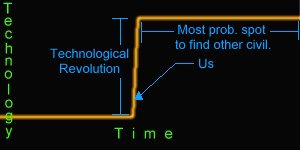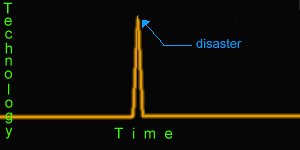Light coming from a star alone filtered to one part in 10,000 amounts to 4 Joules of energy every nanosecond. Therefore, a laser signal coming from near the star must exceed 4 Joules within a nanosecond in order for it to outshine the star. Modern lasers designed for nuclear fusion can exceed this power requirement by some 300,000 times (see the technical paper). Even if the exact frequency of transmission is unknown, such a laser would still outshine the sender's star by 30 times during the nanosecond pulse without any filtering.
Establishing contact as far away as 100 light-years should present no problem. Using research grade equipment, detecting signals from distances up to 1000 light-years are feasible.
Some debate lies within the details of the question of how long each star should be exmined. If we assume that the sending civilization will try to communicate with the nearest 1,000 likely candidates for intelligent life, using modern apparatus capable of redirecting a laser 10 times per second, the civilization could illuminate all 1000 solar systems in 100 seconds. If this is the case, then we could expect to receive a pulse once every 100 seconds. However, if the number changes from the 1,000 to the 1,000,000 closest candidates, then it would take about 28 hours to illuminate the entire field. This would mean that we would have to observe each of a million stars for over a day each; not a feasible research goal. However, it is highly likely that the transmitting civilization might be using multiple transmitters equipped with technology that might allow it to illuminate more than 10 stars per second, thereby reducing the time each star needs to be scanned to a more realistic figure.
As for how long we actually examine each star: about ten minutes. The duration for which we examine each star is determined by a non-OSETI project at Harvard, which is searching nearby stars for extrasolar planets. The Harvard OSETI project piggybacks on this other project, so their OSETI project examines each star that the other project examines, for however long they examine each star. They typically examine each star for ten minutes or more, depending upon the brightness of each star. Since we'll be observing each star simultaneously with Harvard, we'll also be examining each star for about ten minutes, longer for dimmer stars.
Stars similar to our own make likely candidates for having intelligent, communicative life. The closest stars with or capable or having planets and supporting life should be given priority over stars with short life spans and other stellar objects such as close binary stars, which are unlikely to have planets capable of sustaining life.
The list of stars believed to be likely candidates for having intelligent, communicative life, is a subset of those that are being searched for extrasolar planets. We are examining the same stars that the extrasolar planet search based at Harvard is searching.
We are looking for pulses of visible light, several nanoseconds in duration. The amplitude of the pulse must significantly exceed the strength of illumination from the actual star. See Ed Groth's more detailed description of the signals that we and Harvard are looking for.
There is no known preferred frequency or wavelength of visible light. Several have been discussed, such as several wavelengths that are naturally absorbed by stellar or interstellar atoms and ions, and should therefore not naturally be visible. However, unlike in microwave and radio SETI, searching an exact frequency is not vital because the expected transmitting beam should outshine the unfiltered light from the star by at least 30 times.
None that we know of that we cannot compensate for.
- Cerenkov flashes can produce no more than one photon during a nanosecond, not enough to render a significant reading in the detector.
- Lightning from distant storms is also insignificant, since it is unlikely to deliver pulses under a microsecond in duration.
- Atmospheric glow produces a steady stream of photons, but only about 100 per pixel per second in a 1 square meter telescope, which in a 10,000 pixel detector would only result in .001 photons per nanosecond; not nearly enough to render false readings. OSETI can theoretically be conducted during the day, if the sky is clear.
- The high voltages used within our detectors cause electrical arcing within the detectors, which in turn trigger the detectors. We therefore use two detectors, and ignore all "detections" that do not occur in both detectors simultaneously. Only coincident detections in both detectors are considered as possible OSETI events.
- Cosmic rays striking the atmosphere cause cascades of high energy particles and photons, which can in turn trigger our detectors if the photons enter our telescope. Photons generated by one such cosmic ray could not enter both our telescope and Harvard's telescope, so we and Harvard compare the timing of our possible OSETI events to eliminate such atmospheric sources. We detect about one possible OSETI event per hour of observation.
Yes. Please click here for links to the Web pages of other OSETI projects.
A fast optical detection system designed by Paul Horowitz is being used with our 36" reflecting telescope. The detection system uses a beam splitter and two fast photodetectors to check for coincident events (signals in both detectors simultaneously). This eliminates several false detections resulting from events originating in the detection system itself.
One method of determining the number of potentially communicating planets in the galaxy is to use the Drake equation Using this simple calculation, the results of which varies greatly depending on what numbers you use (such as the number of stars with planets, and the lifetime of a communicating civilization), the number of actively communicating civilizations in the galaxy can vary from one to tens of thousands. In a galaxy approximately 300 thousand light-years in diameter in which we are nearly centered, the chances are high that if life exists throughout the galaxy, we would be within a reasonable range to "hear" a signal from another civilization. In the end, the probability depends on whom you choose to ask, but even if the chances of actually finding intelligent life are small, the fact that it would be perhaps the greatest discovery that mankind has ever made makes SETI, OSETI, and other such projects a worthy effort.
If another civilization was actually discovered, chances are they would be far more advanced than us. This stems from the fact that the creation of technology is a rapid and brief process when compared to the time scale of life itself. Life has existed on Earth for thousands of millions of years, yet it is only in the past one or two hundred years that communication technology has really started. In addition, that progress of technology, unless interrupted by some sort of disaster, should continue rapidly until civilization comes in equilibrium with its energy source. At this point the evolution of technology should plateau for the duration of the planet's civilization. In other words, the period of time during which a civilization evolves its communications technology, which might last a few thousand years, is small compared to the millions of years that a civilization might exist. Prior to the advancement of their technology, it would be impossible for them to communicate with us. That leaves only the brief period of technological evolution and the remaining plateau. Since the prior of these two is relatively short in duration, we would most probably encounter a civilization in the plateau, making them far more advanced than us. Another possibility however, is that the civilization undergoes some sort of disaster during the technological revolution resulting in a "spike" on a plot of technology versus time (see below). This would mean that the time period during which the civilization could communicate would be greatly reduced, making it unlikely that we would detect them at all.
Possibility #1: |
Possibility #2: |